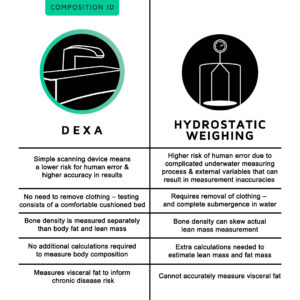When it comes to body composition, you want to know the truth. Several testing procedures have been developed to provide body composition information, but not all methods are created equally.
You work hard in the gym and are consistent with nutrition for a primary outcome: results. For most, tracking results usually means weighing in on a bathroom scale or waiting for a drop in jean size. Numeric values on a typical scale provide a measurement of total body weight, but do not take into account what proportion of the body is comprised of fat, muscle, and bone, also known as body composition. Body composition is the distribution of mass in the body among lean muscle, body fat, and bone, and is a highly accurate indicator of health. When adopting a tailored fitness and nutrition plan, it is important to have a full picture of body fat and lean muscle distribution, as well as the ability to track changes reliably over time to achieve goals.
Body Fat Calipers
Calipers, commonly referred to as the “skinfold test,” is one of the oldest and most common methods of determining body fat percentage. Practitioners “pinch” specific areas of the body to gauge body fat, then use calculations based on age and sex to estimate body composition. Calipers can only estimate total and regional body fat, and cannot determine visceral fat or bone density. There is a risk of human error in this method, as it requires very specific training.
InBody Impedance
InBody uses Bioelectrical Impedance Analysis (BIA) to calculate percent body fat by sending an undetectable flow of electric current through the body to compare total body water to body weight. With a higher margin of error, BIA results can be skewed due to small changes in hydration levels or exercise. It is also difficult to determine regional differences using this method.
Hydrostatic Weighing
Hydrostatic weighing, or underwater weighing, uses Archimedes’ principle in fluid mechanics to measure body fat versus lean mass. It requires the participant to be fully submerged underwater with emptied lungs to calculate an accurate reading. Bone density can sometimes skew actual results, along with other external variables. It also may not be the most comfortable testing experience (let’s save the dunking for summertime pool play).
Bod Pod
Bod Pod devices determine fat and fat-free mass in the body through Air Displacement Plethysmography. Here, a patient sits inside of an egg-shaped “pod” while body volume is measured based on its physical relationship with air pressure. It requires the participant to wear tight-fitting or very little clothing and is based on one-size-fits-all pre-calculated formulas.
In-home Scales
While convenient, in-home scales can be one of the most inaccurate methods of body composition analysis. Some can have a margin of error of up to 20% and no scales accurately measure regional differences. Body shape may also affect results.
3D Scanners
One of the newest methods on the market today are 3D Scanners. These devices usually swivel around the participant (or the participant swivels around the device) to provide a full-body “scan” with body composition data. Because the technology is new, devices are expensive and can be inaccurate due to insignificant algorithm data. Loose-fitting garments can skew results and there is limited oversight from professionals when devices are used in home settings, which can further hinder accuracy.
Why Choose DEXA?
DEXA technology is different. DEXA, or dual-energy x-ray absorptiometry, has clear advantages when compared to traditional testing methods. With the lowest error rate (1-2% compared to 5-15% for most methods), DEXA technology is the most reliable form of body composition testing available commercially. Whereas most methods only provide a proportion of body fat versus lean mass, DEXA offers a comprehensive regional analysis across five sections of the body, which gives clients a specific look at localized fat and muscle distribution and can help identify muscle imbalances to inform potential physical training interventions. Perhaps one of the most unique differentiators between DEXA technology and traditional tests is its ability to include bone mineral content within scan results. Providing clients with a bone density analysis not only assesses their risk of osteoporosis, but also allows for a more accurate overview of body composition compared to other testing methods which only estimate body fat versus all other combined body tissues. A scan takes under 10 minutes and there is no need to remove articles of clothing or worry about dietary nuances (fasting, dehydration, caffeine intake) prior to testing: these do not affect results as they would with body displacement or BIA tests. It is recommended to complete a scan every 30 days after significant changes are made to fitness and nutrition protocols, whereas a scan every three to four months is sufficient for those hoping to monitor and maintain progress.
For those who are looking for a highly accurate, comprehensive, and non-invasive way to examine muscle-to-fat ratio and bone density, DEXA is the ideal technology. Results from a scan work hand-in-hand with Composition Coaching and tailored fitness plans, are intuitively comparable with subsequent scans to make tracking progress easy, and are a valuable resource for individuals ranging from elite athletes to everyday gym-goers. They are also ideal for those who are curious about their overall health and are ready to take steps towards lifestyle modification.
DEXA gives you what you can’t see on the scale, in a new pair of jeans, or through traditional testing methods. It provides an inside look at how your body is built, as well as a simple, reliable way to track body fat and lean muscle changes over time after committing to new fitness and/or nutrition plan. Time and effort spent to produce results deserves a way to actually see results, which is made possible and convenient through DEXA technology.
Learn more about DEXA technology and schedule an appointment with us at a location near you.









